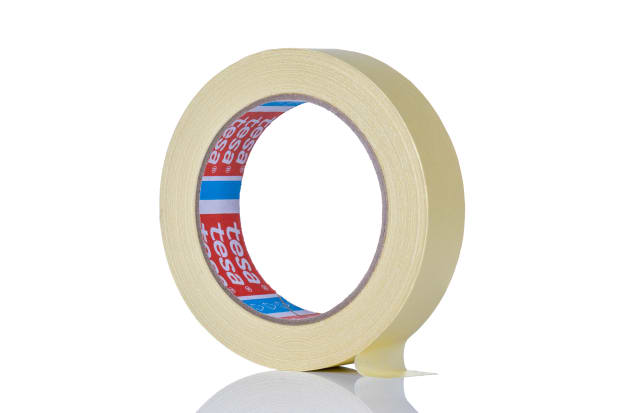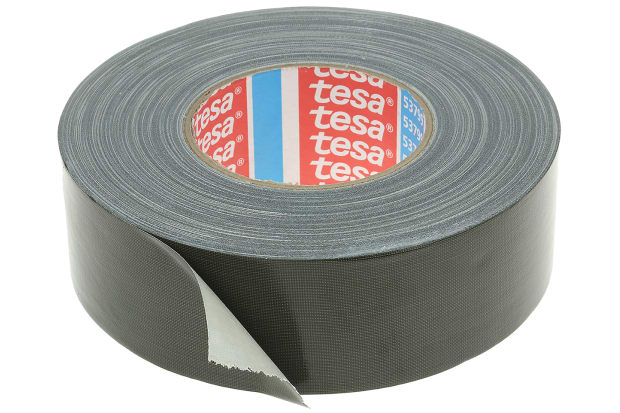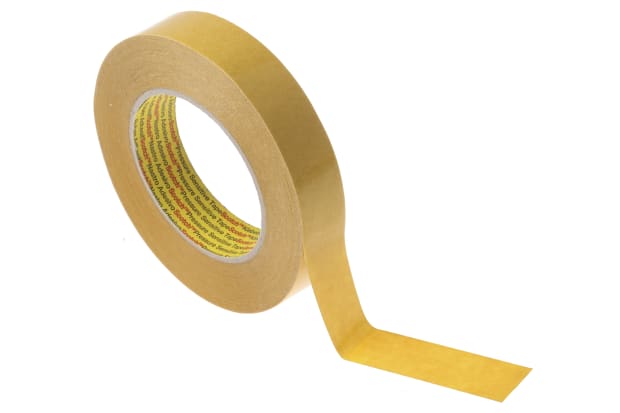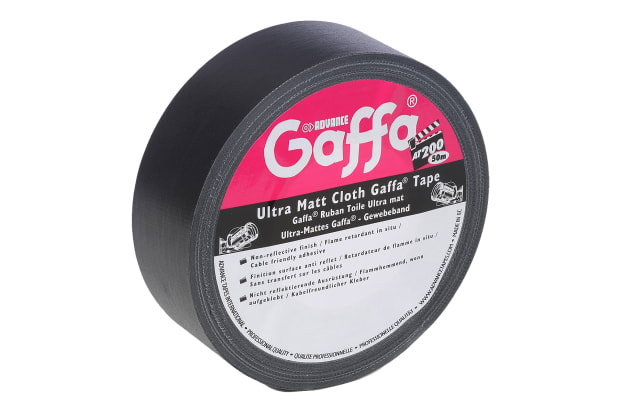- Published 6 Jan 2023
- Last Modified 4 Sept 2023
- 9 min
Everything You Need To Know About Duct Tape

What is duct tape?
Duct tape, also called cloth tape, is a long-lasting adhesive tape which can be easily torn by hand.
It’s suitable for indoor and outdoor use thanks to its strength and water resistance. It’s available in various widths, lengths and colours – with the most common colours being black, silver and clear.
There’s even duct tape that glows in the dark, which is useful for crafts, Halloween decorations or locating items in dark settings. As well as this, there’s double-sided duct tape which is coated in adhesive on both sides. This is ideal for sticking two objects or surfaces together without making holes or the tape being visible.
Duct tape can have different grades, which help determine the applications it should be used for. The grade refers to how the tape is made – so the type of adhesive used and the strength of the cloth backing. The strength of the cloth backing depends on the number of threads it has, with more threads making it stronger and therefore more difficult to tear.
It was originally called duck tape because during World War II the US military needed a waterproof tape to keep moisture out of ammunition cases. Johnson & Johnson manufactured the tape and, because of its water resistance which emulates water off a duck’s back, it was referred to as ‘duck’ tape.
What is duct tape used for?
After the war, it was realised that duct tape is great for sealing joints in heating and air conditioning duct work. That’s when the colour changed from army green to the silver colour most commonly produced today.
Duct tape has now become multipurpose and is used for general sealing, patching holes, packing boxes and repairs. Some duct tape can also stick to rough and uneven indoor and outdoor surfaces such as wood, stone, plaster, brick and metal.
As well as these common uses, there are some other interesting applications for duct tape – some of these are listed below.
Health and fitness
- During exercise, duct tape can be applied to blisters and sores for protection.
- To help improve accuracy when using a punching bag, stick squares of duct tape on as markers.
- Duct tape can be used for a genuine Royal Marine exercise. Simply hold a large roll of duct tape out to one side until it’s impossible to do it any longer, and then repeat with the other arm.
Home repair
- If a screen is broken, keep insects out by covering any holes with duct tape until it’s been fixed or replaced.
- Before removing a broken pane of window glass, criss-cross duct tape over the pane to help prevent it falling apart when being replaced.
Survivalist
- If there isn’t a handy parachute cord available, lengths of twisted duct tape can be used as a cord or rope in an emergency. Twisting the duct tape like this can also make a clothesline.
- Preserve food by resealing packets or cans with duct tape.
- In an emergency, duct tape can be used to make a sling, secure a splint, bandage a wound, or wrap a sprained ankle.
Did you know? Duct tape can be used in space! On the Apollo 17 Lunar Rover's replacement fender, duct tape used to hold together the four maps from which the fender was made
Can duct tape be used as electrical tape?
Electrical tape is a pressure-sensitive tape used to insulate materials which conduct electricity, particularly electrical wires. It stops the electrical current from accidentally passing to other wires, which could create a short or even cause an electrical fire. It also prevents possible electrocution in case live wires are touched.
Electrical tape may look like any other kind of tape, but it has very distinct benefits which make it unique. It’s designed to be non-conducting and usually doesn’t harden quickly like duct tape, plus it stays well secured in common wiring applications.
It can also be removed more easily than duct tape and is more stretchable, which makes for a tighter hold on electrical wires.
Electrical tape is safer as it’s intended for use with electrics, and so duct tape shouldn’t be used for these types of tasks. There’s a wide range of electrical tapes to choose from which make it easier and safer to work with electrics.
How is duct tape made?
Duct tape is typically made from three different layers. The top layer, which is exposed, is made from a plastic called polythene. Underneath that, there’s a middle layer made of fabric, while the bottom layer is a rubber-based glue.
To make duct tape, the fabric is covered in melted polythene, which protects it from moisture and erosion. The polythene coating is flexible enough to allow the tape to stick to uneven or rough surfaces.
Unlike other tapes, the fabric backing gives duct tape strength while still allowing it to be easily torn by hand.
Is duct tape paintable?
Duct tape is designed to be moisture and water resistant, meaning if it’s painted it will look patchy and eventually the paint will peel or flake off. The paint will also form in the lines and texture of the tape and leave an uneven finish.
Will duct tape damage car paint?
Getting rid of duct tape residue from the paintwork of a car can be difficult because the glue it’s made with is very durable and therefore quite hard to clean off.
If the adhesive is stuck to the metal surface, there are ways it can be removed while avoiding scraping or scratching the paint when cleaning it off. Outlined below is one method of removing it.
Start by getting the following items:
- A bucket of hot water
- A wash rag
- A clean, soft cloth
- Commercial solvent/degreaser
- An old gift card or credit card
The first step is to soak the glue left on the paintwork. Hold a wet wash rag over the duct tape residue for a few minutes to help loosen it, then wipe off as much of the glue as possible. The longer the duct tape has been stuck on the car, the more difficult it can be to completely remove the glue.
Choose a solvent which is suitable for use on cars, then apply with a clean, soft cloth. This will chemically break down the bonds between the glue and the metal of the car.
Refrain from using products such as nail polish remover or acetone to remove the glue, as these products could take off the top layer of paint. Also, don’t use WD-40 as this could cause an oily residue to soak into the paintwork, which is potentially even more difficult to clean off.
Use the edge of an old credit card or a gift card to carefully scrape off any remaining glue. If it’s still needed, then reapply a final coat of degreaser and follow any instructions it comes with to remove any last bits of residue.
Using Duct Tape for Ducts
Duct tape can be used for sealing gaps in ductwork to reduce air leaks, however, it should only be a short-term fix. If the tape is left on too long, it won’t seal leaks effectively and heated and cooled air will be lost through the gaps.
So while duct tape is useful for a quick and temporary fix, over a long period it will lose its sticky qualities – especially in a humid environment such as ductwork.
Alternative duct sealing products
- Injected aerosol sealant
- Duct mastic sealant
Duct Tape not suitable for your application? Take a look at the table below to help you understand what different tapes are available and their uses:

Masking tape
Duct tape is a stronger, more permanent adhesive product than masking tape. Masking tape is made by attaching a lighter glue to the back of thin paper. It’s generally used for temporary fixes and usually won’t leave marks when removed.

Packing tape
Packaging tape doesn’t have a cloth backing like duct tape, but it’s still durable enough to keep boxes sealed.
The fact it doesn’t have a cloth backing makes it a lot easier to cut or tear by hand – ideal for instances such as moving house. It doesn’t have the waterproof qualities of duct tape and it won’t leave a sticky residue like duct tape often can.

Cloth tape
Cloth tape has polythene and gauze fibre as its base material. It’s insulating tape which has strong stripping force, tensile resistance, oil resistance, ageing resistance, heat resistance, water resistance and anticorrosion. Cloth tape is usually used for carton sealing, carpet seam joints, and water-proof packaging

Foil tape
Foil tape is a flat, thin metal tape coated with adhesive. It should really only be used for sealing small holes and gaps.

Washi tape
Washi tape is a thinner and more lightweight tape which is made from paper. It doesn't hold on to things permanently, and is more designed for crafts.

Gaffa tape
A less common version of duct tape is gaffa tape. It’s more heat resistant and can be removed from a surface without leaving residue. Gaffa tape is often more expensive than duct tape as it’s produced in smaller quantities.
Can duct tape catch on fire?
The mesh fabric used to make duct tape is flammable, however, it’s also coated with polythene which isn’t flammable. As rubber isn’t flammable either, this means that the glue used on duct tape is also safe from fire.
So while it isn’t a flammable product, extreme temperatures will make it difficult for the glue to effectively stick to a surface which is too hot or too cold.
What’s the best duct tape to use?
There are many different types of duct tape to choose from. To help, here are some of the most popular brands. Click through to view the full product range: